The DRC vows to become a world leader in car batteries but challenges remain.
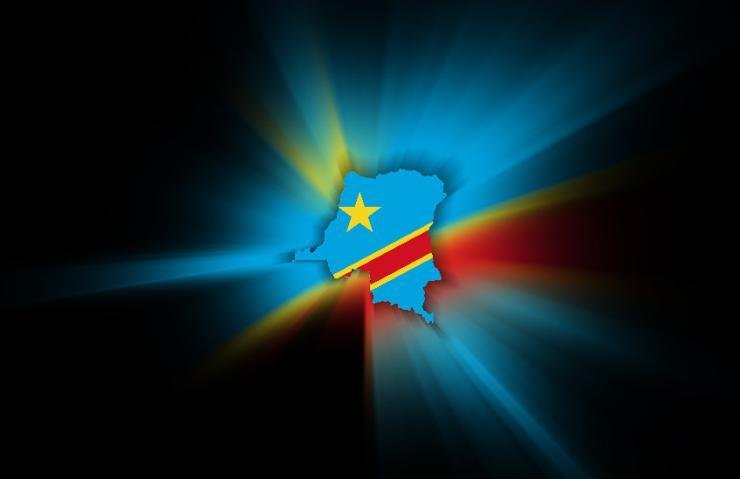
The country has the ambition to become the world leader in batteries for electric cars. But despite its huge mining assets, important challenges must be addressed.
Besides its copper and gold mines, the Democratic Republic of the Congo (DRC) is endowed with the minerals of the energy transition. During his visit to President Felix Tshisekedi in September 2022, Amos Hochstein, the United States Senior Adviser on Energy Security, said that Washington considered the DRC as a strategic country in a context where the Ukraine war highlights the need to diversify the energy mix in order to avoid dependency from a single producer.
At the G20 summit of Bali, by mid-November 2022, the Congolese Minister of Industry, Julien Paluku stressed that the DRC is the best location for the batteries and electric vehicles industries, with its reserves of cobalt, lithium, and manganese. Paluku also urged foreign partners in helping the DRC to set up the first batteries plant in the Upper Katanga province, in a partnership with neighbouring Zambia.

Democratic Republic of the Congo, President Felix Tshisekedi.
During the COP 27 conference in Sharm El Sheikh, last November, Paluku declared that the Afreximbank, the Africa Finance Corporation and the Arab Bank for the Economic Development of Africa (BADEA) were supporting the project. Accordingly, the challenge for the DRC and other African countries is to win a share of the market of 900 million electric vehicles which will be built between now and 2050. The UN Economic Commission for Africa (ECA) is recruiting a firm that will carry out the pre-feasibility study of the plant.
In January 2022, President Tshisekedi had already instructed the Minister of Mines, Antoinette N’Samba, to prepare a plan of action for the beneficiation of these strategic minerals, in the wake of the DRC-Africa Business Forum which took place in Kinshasa in November 2021. On that occasion, President Tshisekedi presented his country as the most competitive destination for investments in batteries for electric cars and invited fellow African leaders to participate in future battery production projects in the DRC.
The call was prompted by a study made by Bloomberg NEF and commissioned by the ECA which identified the DRC as the best destination for the manufacturing of sustainable battery materials used in high-nickel batteries, as Congo can leverage abundant cobalt resources and hydroelectric power to become a low-cost and low-emissions producer of lithium-ion battery cathode precursor materials.
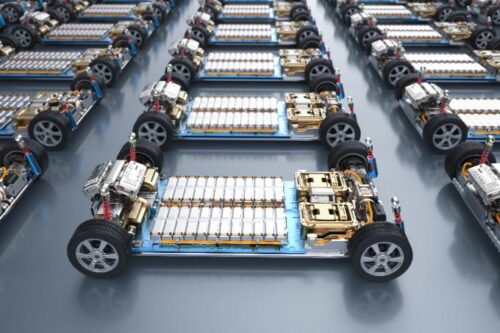
Electric cars with a pack of battery cells module. 123rf.com
According to the study, such a plant with a 10,000 tons cathode precursors capacity would cost only U.S. $39 million, three times cheaper than in the U.S. owing to cheaper access to land, low engineering procurement and construction. The expected boom of electric cars according to the study represents a $7 trillion market between today and 2030.
On the last 29 April, Tshisekedi and Zambian President Hakainde Kichilema signed an agreement in Lusaka, to set up a cooperation strategy involving the creation of a batteries plant.
The deal also includes the creation of a Council of Batteries in each country, including representatives from the ECA and the Afrexim Bank. Morocco, Gabon, the African Development Bank, Tesla, Bosch and Panasonic attended the ceremony.
Such enthusiasm is justified by Congo’s dominant position on the cobalt world market, with production representing nearly 70% of the world total and reserves which represent more than half of the world’s total. Cobalt production is likely to soar since electric vehicle sales are forecast to increase by 30% to meet the related demand needs of batteries which amounts to 57% of the total demand which also includes the supplies for the aerospace and manufacturing sectors.
The DRC also hosts large reserves of lithium estimated at 6.61 m. tonnes by the operator of the main mine, the Australian company AVZ Minerals whose Manono project, in the Tanganyika province which it owns with the state-owned Congolaise de l’exploitation minière (Cominière) as a junior partner, is the world’s largest deposit according to peer comparison information compiled by AVZ. Production is scheduled to start this year. The market prospects look bright since according to the International Energy Agency, the lithium demand could increase 40-fold over the next 20 years.
AVZ is making steps to cope with the rising demand. In February 2020, it signed a memorandum of understanding (MoU) with the Congolese Ministry of Water and Energy to refurbish the Mpiana-Mwanga hydroelectric power plant, on the Luvua River, at 87 km from the mine and increase its capacity from 18 MW to 54 MW.

Gécamines offices in DRC’s capital, Kinshasa. (Company’s website.)
But the development of the project might be hampered by a controversy between Congolese politicians over the location of the processing plant. MPs from the Tanganyika and Upper Lomami provinces, where lithium mines are located are objecting to government plans to set up the processing plant in the Upper Katanga province.
Then, the CEO of AVZ’s main shareholder, the Dathcom company was sentenced to three-year prison for having forged shares by the Lubumbashi court of appeal in November 2022.
Other companies are rushing for lithium. Canada’s Tantalex Resources is developing a project on the Manono-Kitotolo lithium, tin and tantalum heaps and plans to start also production by 2023. The Australian company Critical Resources is developing with Cominière the Kitotolo-Katamba project, in the same area and the Kanuka mine in the Upper Katanga province, in association with Mining Mineral Resources (MMR).
The DRC also hosts sizeable manganese deposits which may be useful for the batteries industry in the Lualaba province where state-owned company Société commerciale minière de Kisenge-Manganese (SCMK-M) has a stockpile of already mined 400,000 tonnes of manganese at its open-pit mine of Kisenge. Since 1982, the manganese operation has come to a standstill but the project could resume if the 432 km railway line between Kolwezi and the Angolan border is rehabilitated, allowing the ore to be exported through the port of Lobito on the Atlantic.
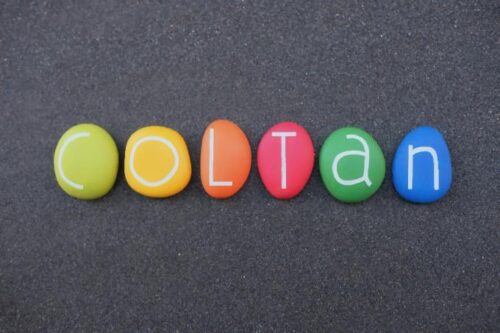
123rf.com
Martin Kepman, the CEO of the Manganese X Energy Corporation is indeed convinced that manganese can replace cobalt in the lithium ion battery industry. Tesla’s CEO, Elon Musk has vowed to eliminate cobalt from the batteries used by his company. In 2020, researchers from the University of Texas found cobalt-free cathode composition that works equivalently containing manganese, nickel, and aluminium. One of the advantages of manganese is that is far more affordable than cobalt.
The DRC has not yet any issued prospecting licenses for rare earths elements used for nickel-metal hydride batteries namely. But researchers from the Pan African University’s Life and Earth and Life Sciences Institute, mention potential rare earths deposits in carbonatite complexes in the North Kivu, Maniema, North-Eastern Orientale Province, Haut-Uele, Ituri, Katanga, Kasai and Kongo Central provinces.
Yet, in order to transform the grandiose ambitions of creating a world production hub of batteries into reality, several challenges must still be addressed. According to the executive secretary of the ECA, Vera Songwe, the materialization of such projects requires “plenty of reliable and affordable power, which can be achieved by connecting Africa’s power systems with the Grand Inga at the core “. But there is still a long way to go. Since the withdrawal from the Inga project in 2021 of the Chinese consortium led by the Three Gorges Corporation, no major progress has been achieved yet by the Australian firm Fortescue which was selected to develop it.
The mining industry is currently facing an electricity supply shortage of over 1,000 MW according to the Chamber of Mines.
Disputes between the government and mining companies may delay projects. One example is the dispute between the majority shareholder of the large copper and cobalt mine, Tenke Fungurume, the China Molybdenum Company and its minority partner, the Congolese state-owned mining company, Gécamines. As a result, Tenke Fungurume has not been allowed to continue its exports since July 2022.
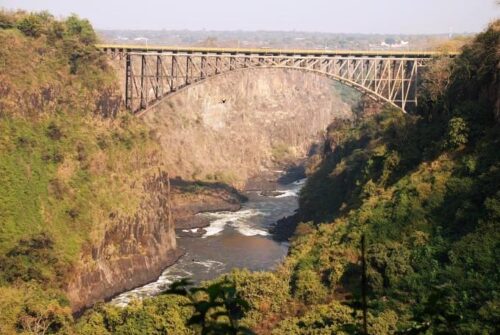
The Victoria Falls bridge linking Zambia and Zimbabwe which can only support one truck crossing at a time.
The DRC also faces logistical handicaps. The Manono lithium mine is located in the landlocked province of Tanganyika, at 640 km fromo Lubumbashi and the road is in a very poor state.
Another constraint is the transfer of minerals by ship on the Lake Tanganyika which have to be unloaded before being transported by truck or by train to the port of Dar-es-Salaam.
A Bloomberg report, published in November 2022, highlighted that the DRC is faced with chronic bottlenecks at the border with Zambia. Trucks can be locked two weeks, in traffic jams. The whole journey can take a month between a Congolese mine and a South African port.
Another bottleneck is the Victoria Falls bridge linking Zambia and Zimbabwe which can only support one truck crossing at a time.
In South Africa, truck hijackings jumped by a third in the first quarter of 2022, according to official crime statistics while the container port of Durban ranked as one of the least efficient ones in the world according to a World Bank study of 2020.
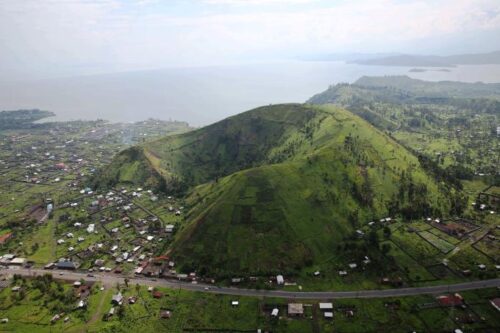
DR Congo. North Kivu. View of a crater on the outskirts of the city of Goma. Photo MONUSCO/Abel Kavanagh
The Congolese batteries production plans are facing also a political problem. The caucus of MPs of the Tanganyika province complains that local people have not been involved in the discussions about the beneficiation of the lithium ore at the DRC Africa Business Forum, including the location of future processing factories.
Another important challenge is security. Whereas cobalt and manganese deposits can be mined in relatively safe environments, the situation is different for rare earths and lithium. The provinces of North Kivu, South Kivu and Ituri are under state of siege since May 2021. Endemic violence provoked by the clashes between the Twa and Lubakat militias is also posing a potential threat to the lithium projects of the Tanganyika province. Finally, the exploitation of lithium bears negative consequences for the environment. The process of extraction of lithium from hard rocks in the form of spodumene is quite damaging since it requires the use of dynamite and the drilling of wells that can be served l hundred meters deep, which can cause soil and air pollution. Soon or later, these issues will have to be addressed to meet the criteria of the environmental lobbies worldwide. (Open Photo: 123rf.com)
François Misser



